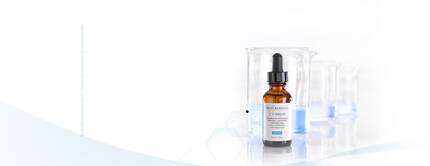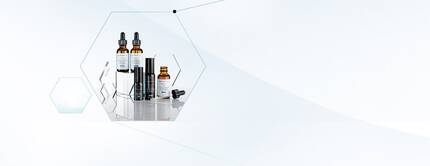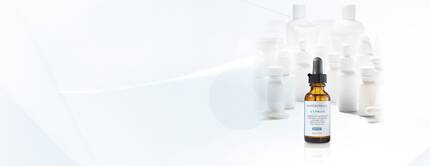
ANTIOXIDANT SCIENCE
Properly formulated topical antioxidants have been shown to neutralize skin-damaging free radicals. Some improving the appearance of fine lines, wrinkles, and discoloration.
But what are antioxidants, how do they work, and what other benefits do these active molecules have for the skin?
Antioxidant Science
Properly formulated topical antioxidants have been shown to neutralize skin-damaging free radicals. Some improving the appearance of fine lines, wrinkles, and discoloration.
But what are antioxidants, how do they work, and what other benefits do these active molecules have for the skin?

WHAT IS AN ANTIOXIDANT?
An antioxidant is a molecule that inhibits the oxidation of other molecules.
Oxidation is a type of damage that occurs when molecules lose electrons. Five types of antioxidants found naturally in the body that protect against cellular damage are: glutathione, ubiquinone, ascorbic acid (vitamin C), alpha tocopherol (vitamin E), and alpha lipoic acid. Antioxidants work by different mechanisms to stop or neutralize damage. Out of the five antioxidants found in the body only vitamins C and E have been proven to get into skin. Additionally, there are a few plant antioxidants known to work in skin.

WHAT’S A FREE RADICAL?
Free radicals are molecules with unpaired electrons, causing them to be unstable and highly chemically reactive.
These unstable molecules are generated by UV rays, pollution, and lifestyle factors like alcohol and cigarette smoke. Over time, free radical damage leads to visible signs of accelerated skin aging, including fine lines, wrinkles, laxity, discoloration, and even skin cancer.
While sunscreen is the first line of defense and essential for protecting skin from UVA and UVB rays, sunscreen rays filters may only protect skin from up to 55% of free radicals*. Topical antioxidants work to neutralize free radicals and protect against UV damage. Incorporating a topical antioxidant and sunscreen into a daily skincare regimen provides complete protection from environmental damage.
*Haywood, R., et al, J Invest Dermatol 2006;121:862-868

SKINCEUTICALS:
THE ANTIOXIDANT AUTHORITY
In 1997, SkinCeuticals changed the face of skincare with the introduction of Serum 10 and Serum 15, the company’s first stabilized, pure L-ascorbic acid topical antioxidants
SkinCeuticals founding scientist Dr. Sheldon Pinnell conducted research about antioxidant formulation and discovered specific formulation factors, now known as the Duke Antioxidant patent. SkinCeuticals is the only brand to formulate antioxidants according to these standards.

THE SKINCEUTICALS DIFFERENCE
A topical vitamin C antioxidant must be formulated properly to be effective on skin. This is dependent on three factors: The form of vitamin C used, the concentration, and the pH of the solution.
In the years since the patent, each subsequent antioxidant generation has been subjected to rigorous clinical studies—and the results are clear: SkinCeuticals vitamin C serums neutralize free radicals caused by solar radiation and other environmental factors while helping to maintain and improve the overall appearance of skin.

An antioxidant is a molecule that inhibits the oxidation of other molecules.
Oxidation is a type of damage that occurs when molecules lose electrons. Five types of antioxidants found naturally in the body that protect against cellular damage are: glutathione, ubiquinone, ascorbic acid (vitamin C), alpha tocopherol (vitamin E), and alpha lipoic acid. Antioxidants work by different mechanisms to stop or neutralize damage. Out of the five antioxidants found in the body only vitamins C and E have been proven to get into skin. Additionally, there are a few plant antioxidants known to work in skin.

Free radicals are molecules with unpaired electrons, causing them to be unstable and highly chemically reactive.
These unstable molecules are generated by UV rays, pollution, and lifestyle factors like alcohol and cigarette smoke. Over time, free radical damage leads to visible signs of accelerated skin aging, including fine lines, wrinkles, laxity, discoloration, and even skin cancer.
While sunscreen is the first line of defense and essential for protecting skin from UVA and UVB rays, sunscreen rays filters may only protect skin from up to 55% of free radicals*. Topical antioxidants work to neutralize free radicals and protect against UV damage. Incorporating a topical antioxidant and sunscreen into a daily skincare regimen provides complete protection from environmental damage.
*Haywood, R., et al, J Invest Dermatol 2006;121:862-868
THE ANTIOXIDANT AUTHORITY

In 1997, SkinCeuticals changed the face of skincare with the introduction of Serum 10 and Serum 15, the company’s first stabilized, pure L-ascorbic acid topical antioxidants
SkinCeuticals founding scientist Dr. Sheldon Pinnell conducted research about antioxidant formulation and discovered specific formulation factors, now known as the Duke Antioxidant patent. SkinCeuticals is the only brand to formulate antioxidants according to these standards.

A topical vitamin C antioxidant must be formulated properly to be effective on skin. This is dependent on three factors: The form of vitamin C used, the concentration, and the pH of the solution.
In the years since the patent, each subsequent antioxidant generation has been subjected to rigorous clinical studies—and the results are clear: SkinCeuticals vitamin C serums neutralize free radicals caused by solar radiation and other environmental factors while helping to maintain and improve the overall appearance of skin.
